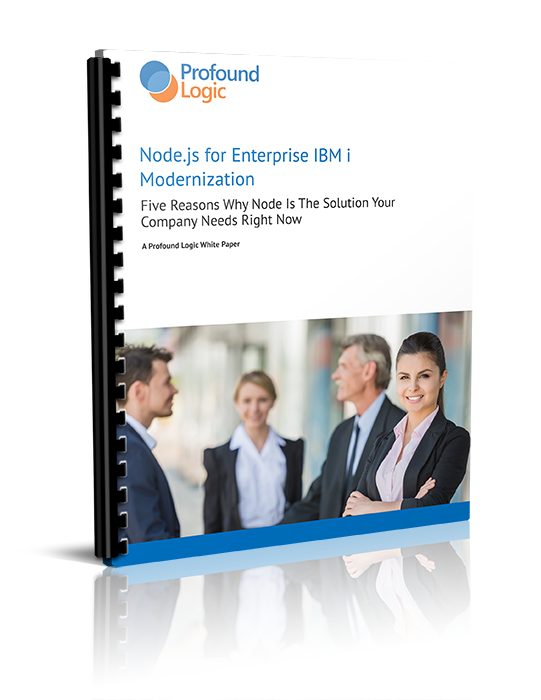
Glad to have you back for this week's IBM i Pulse! Each week we will be taking a deeper look into this week's IBM i news. This week we are looking at what to do with RDi, Watson and Bluemix, HA availability, and the future of App Dev. But First...
Guru: How Do You Do That With RDi?
by Susan Gantner
In this article Susan continues her discussion on how to do certain high level executions with RDi. She talks about two common issues that people continue to bring up to her that keep people returning to PDM for their compiles rather then using the RDi compile interface. Those two issues are their library lists aren't set up correctly or they need to do something in addition to a simple compile command. Check out her answers to these questions here.
IBM i, Watson & Bluemix: The REST of the Story
by Dan Burger
IMB introduced Bluemix a few years ago which is a framework that allows applications on other systems to connect with business logic on the IBM i. Bluemix tooling was created to consume REST API's, which can be used to connect your IBM i to Watson (a REST API is a way to externalize a service, function or logic that doesn't require knowledge of the language it is running on).
Tim Rowe, business architect for IBM i application development, said, "A year ago, we were talking about how to connect Bluemix to IBM i... REST API's made that possible. This is part of a bigger issue of being relevant today and in the future. RPG is another part. There are many tooling pieces."
Along with the development of BlueMix, IBM has been seeking a way to integrate their flagship program, Watson, with their current IBM i systems. That starts with open source alternatives that allow languages like RPG and COBOL to seamlessly work with more modern user interfaces. This is evident in the leveraging of PHP, Python and Node.js. IBM now wants to leverage Watson in the same way. They want to help companies be successful today and successful in the future.
The use of Node.js has been an huge part in thousands of modernization efforts by companies who's transactional processing is still with RPG. Profound Logic is the leader in that modernization effort and that is evident in their newest product, Profound.js 2.0.
Understanding IBM i Options For High Availability
by Alex Woodie
The term High Availability is in reference to the capability to keep your applications running in the event of an outage... planned or unplanned. Redundancies, failure detection, and fail over capabilities are some of the solutions that High Availability (HA) build into lo-level system architecture.
In a broad sense, there are really two types of HA software for the IBM i... logical replication software and hardware based solutions. Each having its own unique solution. Within this article Alex breaks down the differences between a Logical replication and a hardware based solution.
- Logical Replication HA - This setup traditionally has at least two IBM i servers; one acting as the primary box and the other to serve a backup. Larger companies might require a third server in their HA setup.
- Hardware-based HA - This method is a newer one to the IBM i world, but is widely accepted in the Windows world. This has started to become adopted by larger IBM i companies that are more familiar with SANs and the advanced virtualization technologies that accompany them.
For more information on Alex's breakdown of the HA options available to your IBM i shop, click here.
And Finally...Tomorrowland: Optimism, Risk, and Preparation For IBM i App Dev
by Dan Burger
Two of our own, Liam Allan and Ted Holt, were featured in an article on making application development preparations for the future.
"Liam Allan is one of the bright young and innovative talents in the IBM i community. He’s an IBM i Innovation Award winner, a Power Systems Champion and an open source on IBM i advocate. His view of what will become important for future app dev on IBM i was briefly stated as the use of containers (used for packaging applications) and the incorporation of DevOps (collaboration that involves blowing up individual silos and integrating tools and processes)."
"Ted Holt as the senior technical editor of Four Hundred Guru. He’s a published author of books and articles, taught at the university, community college and vocational-technical school levels, and worked in the information industry for more than 30 years. For years, he has said developers have no choice but to learn programming beyond RPG, CL, DDS, PDM, SEU, and SDA. 'The fact that users are less reliant on programmers has freed programmers for more important work, notably modernization of applications and integration with other systems. As much work remains to be done in these areas, the demand for programmers will continue to be steady for some time.'"
Check out the full article here for more info on what Liam, Ted and the other experts had to say.
One of our focuses for 2017 is the continued adoption of Node.js in IBM i shops. Click here to read our white paper on Why Node.js Is The Solution Your Company Needs.
Also, Profound.js 2.0 has been released! See how Profound.js 2.0 can help modernize your IBM i today!
And there, you're all caught up! Sounds like we have an interesting 2017!





